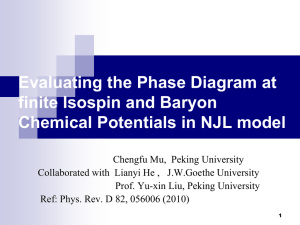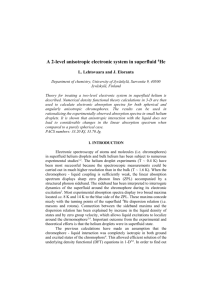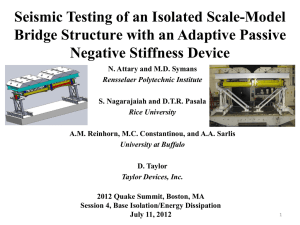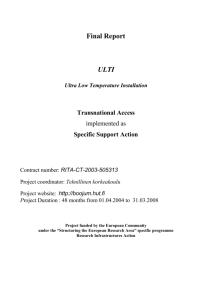Amplitude Fluctuations
advertisement
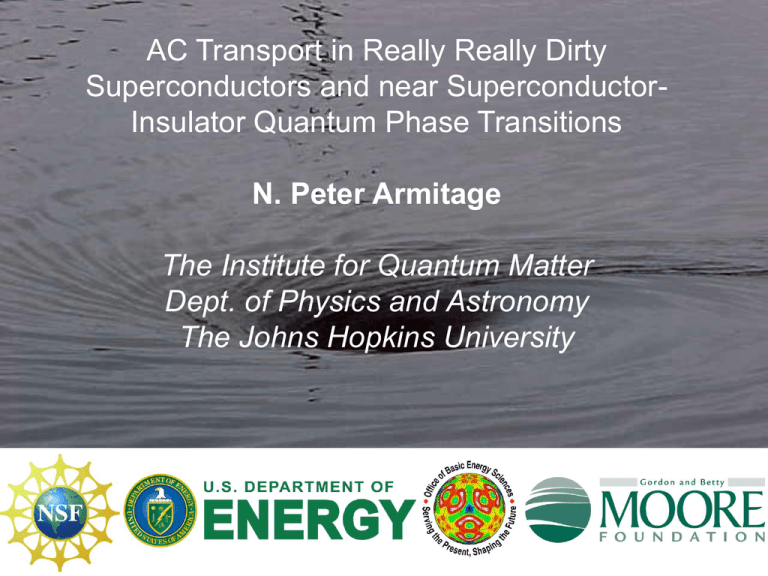
AC Transport in Really Really Dirty Superconductors and near SuperconductorInsulator Quantum Phase Transitions N. Peter Armitage The Institute for Quantum Matter Dept. of Physics and Astronomy The Johns Hopkins University Please visit http://strongdisordersuperconductors.blogspot.com/ Read Post Comment Etc. AC Transport in Really Really Dirty Superconductors and near SuperconductorInsulator Quantum Phase Transitions N. Peter Armitage The Institute for Quantum Matter Dept. of Physics and Astronomy The Johns Hopkins University Effects of disorder on electrodynamics of superconductors? “Low” levels of disorder captured by BCS based Mattis-Bardeen; Dirty limit (1/t >> D). Higher levels of disorder one must progressively consider… Fluctuating superconductivity (thermal fluctuations) Quantum transition to insulating state? Quantum fluctuations?; Character of insulating state? Effects of inhomogeneity self-generated granularity Superconductor AC Conductance @ T=0, D Real Conductivity Imaginary Conductivity Mattis – Bardeen formalism: Electrodynamics of BCS superconductor in the dirty limit Sign depends on whether perturbation is even or odd under time reversal. Dipole matrix element is odd, so Case II coherence factors. Mattis – Bardeen formalism: Electrodynamics of BCS superconductor in the dirty limit ~ 0.D Dissipation T=0 Case II (s-wave Supercond) Case I (SDW) sn sn Case II (s-wave Supercond) 1 Frequency /D 2 Case I (SDW) 0.5 Frequency T/Tc 1 Mattis-Bardeen prediction for type II coherence Klein PRB 1994 Thin films transmission through Pb films Palmer and Tinkham 1968 (earlier Glover and Tinkham 1957) Cavity perturbation of Nb samples; Klein PRB 1994 Mattis-Bardeen prediction for type II coherence Klein PRB 1994 For a collection of particles of density n of mass me, there is a sum rule on the area of the real part of the conductivity (f-sum rule of quantum mechanics). 2D Gap 2D Gap 2D Gap 2D Gap Superconducting Fluctuations; Thermal and Quantum Temperature (Kelvin) TKTB Tc0 Fluctuations can be enhanced in low dimensionality, short coherence length, and low sf density dirty - Transverse phase fluctuations Vortices x ei ≠ 0 – Longitudinal phase fluctuations; “spin waves”; . ei ≠ 0 (in neutral superfluid) Size set by phase `stifness’ Normal State Amplitude Fluctuations Phase Fluctuations - Below Tc0 D>≠ 0 Superconductivity Resistance W/ c Thermal superconducting fluctuations Different T regimes of superconducting fluctuations De Order parameter - Amplitude (D) fluctuations; Ginzburg-Landau theory; D ≠ 0 Amplitude Fluctuations Superfluid (Phase) Stiffness … Many of the different kinds of superconducting fluctuations can be viewed as disturbance in phase field De Order parameter Energy for deformation of any continuous elastic medium (spring, rubber, concrete, etc.) has a form that goes like square of generalized coordinate e.g. Hooke’s law U = ½ kx2 Superfluid (Phase) Stiffness … Superfluid density can be parameterized as a phase stiffness: Energy scale to twist superconducting phase q1 q2 q3 q4 q5 q6 D eq Uij = - T cos Dqij (Spin stiffness in discrete model. Proportional to Josephson coupling) Energy for deformation has this form in any continuous elastic medium. T is a “stiffness”, a spring constant. Superconductor AC Conductance @ T=0, D Real Conductivity Imaginary Conductivity Superfluid (Phase) Stiffness … Superfluid density can be parameterized as a phase stiffness: Energy scale to twist superconducting phase q1 q2 q3 q4 q5 q6 D eq Uij = - T cos Dqij (Spin stiffness in discrete model. Proportional to Josephson coupling) Energy for deformation has this form in any continuous elastic medium. T is a “stiffness”, a spring constant. Kosterlitz-Thouless-Berezenskii Transition KTB showed that one can have topological power-law ordered phase at low T <(0) (r)> ~ 1/r Since high T phase is exponentially correlated <(0) (r)> ~ e -r/ a finite temperature transition exists Transition happens by proliferation (unbinding) of topological defects (vortex - antivortex) Coulomb gas Superfluid Stifness s Mermin-Wagner Theorem --> In 2D no true long-range ordered states with continuous order parameters TKTB p/ s bare superfluid stiffness s BCS rs TKTB Temperature Tc0 Superfluid stiffness falls discontinuously to zero at universal value of s/T If r >> l2/d then charge superfluid effect should be minimal Frequency Dependent Superfluid Stiffness … Kosterlitz Thouless Berzenskii Transition Superfluid stiffnes TKTB = p/ s increasing bare superfluid density =inf Probing length set by diffusion relation. =0 TKTB Temperature Tm In 2D static superfluid density falls discontinuously to zero at temperature set by superfluid density itself. Vortex proliferation at TKTB. Superfluid stiffness survives at finite frequency (amplitude is still well defined). Approaches ‘bare’ stiffness as w gets big. See W. Liu on Friday Phase Stiffness(Kelvin) Time scales? Fisher-Widom Scaling Hypothesis “Close to continuous transition, diverging length and time scales dominate response functions. All other lengths should be compared to these” Scaling Analysis Characteristic fluctuation rate of 2D superconductor See W. Liu on Friday And what about at higher disorders? Superconductor-Insulator Transition Left: Bi film grown onto amorphous Ge underlayer on Al2O3 substrate. Data suggests a QCP [Haviland, et al., 1989] Right: Ga film deposited directly onto Al2O3 substrate. [Jaeger, et al., 1989] Thickness tuning tunes disorder; dominant scattering is surface scattering Phase Diagram for Homogeneous System? Thermal T0 Phase Dominated Amplitude Dominated Transition: “Dirty” Bosons Transition TKTB Amplitude defined Phase defined = D(x,t) ei (x,t) Superconducting Bc Insulating Quantum “Bc2” Can get it from s2 Superfluid Stiffness @ 22 GHz By Kramers-Kronig considerations, to get large imaginary conductivity one must have a narrow peak in the real part. (Stay tuned for Liu et al. 2012. Full EM response through the SIT. Preview on Friday W. Liu.) Effects of inhomogeneities? Coupled 1D Josephson arrays, with two different JJs per unit cell (same as inhomogeneous superfluid density) K Considered extensively in the context of the bilayers cuprates I A new mode! Oscillator strength depends on difference in JJ couplings Super current depends on weaker JJ coupling L.N. Bulaevskii 1994 D. van der Marel and A. Tsvetkov, 1996 (probably many others) EF In random system, the supercurrent response will be governed by weakest link (strength of delta function is set by weakest link). Spectral weight (set by average of links) has to go somewhere by spectral weight conservation. (Remember coupling is density and there is a sum rule on conductivity set by density). Finite frequency absorptions set by spatial average of superfluid density! Many models addressing these general ideas. Much newer work… (sorry Nandini…) How to discriminate the ballistic response of a Cooper pair that crosses a scing patch in time t from a homogeneously fluctuating superconductor on times t ? Phase fluctuation effects important Evidence for non-trivial electrodynamic response on insulating side of SIT Inhomogeneous superfluid density gives dissipation How can we discriminate the ballistic response of a Cooper pair that crosses a scing patch in time t from a homogeneously fluctuating superconductor on times t ?





